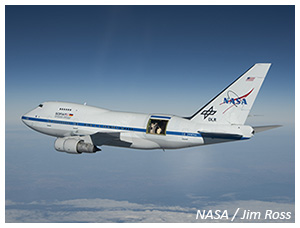Call for Observing Proposals: SOFIA Cycle 9
Arielle Moullet NRAO

SOFIA, the Stratospheric Observatory for Infrared Astronomy, the only aircraft-based facility offering an access to the 4-600 µm wavelength range, has recently released calls for proposals for the Cycle 9 period. The deadline for submitting proposals is 4 September 2020 (9:00 pm PDT). Anyone in the astronomy scientific community is welcome to apply for time, and US-based proposers are also eligible for funding opportunities listed below.
Two Calls for Proposals are offered:
- A Call for regular programs, for which approximately 500 hours of observations will be offered and funding up to $4 million is expected to be available for eligible proposers.
- A Call for the SOFIA Legacy Program, which enables programs producing a rich archival data set of significant scientific value to the astronomical community. Up to four legacy proposals will be accepted, with each allocated up to ~400 hours of observing time (~200 hours of observations per cycle in total). Funding is expected to be available at the level of $2 million per year.
All six instruments — EXES, FIFI-LS, FORCAST, FPI+, GREAT, and HAWC+ — will be available during the Cycle (1 July 2021 to 30 September 2022). SOFIA plans to offer three Southern deployments: two long deployments (July-September 2021 and 2022) offering GREAT and HAWC+, and a short deployment in March 2022 offering FIFI-LS.
Proposals are to be submitted through the USPOT tool. The Help Desk is open to answer any question and inquiry from the community: [email protected].
Proposal Preparation Webinar: 18 August, 8:00-10:30 am PDT
A proposal preparation webinar will be held on Tuesday, 18 August, at 8:00 am PDT on Webex. This webinar is intended to provide practical information to both experienced and prospective SOFIA users on how to best design a scientifically and technically strong SOFIA proposal for Cycle 9.
For each SOFIA instrument, science staff members will present realistic science examples and demonstrate how to determine the necessary signal to noise, choose the observing strategy, determine the observing time estimation with SITE, and design the corresponding Astronomy Observation Request with USPOT. A general presentation will introduce the main science cases addressed by SOFIA, and the general capabilities of the instrument suite, as well as the specific features offered during Cycle 9, including the Dual Anonymous Review framework. There will be ample time for questions.
The preliminary agenda and more connection information are available on the SOFIA Science Center web page. Slides from the webinar and associated video tutorials for the 2019 Proposal Tool webinar are available online.
New for SOFIA in Cycle 9
- Starting with Cycle 9, the observatory is adopting a policy of "two-year" proposals: accepted regular proposals with priority 2 and 3 will stay active in Cycle 9 and Cycle 10. Priority 1 regular proposals and Legacy Proposals will continue to remain active until completed.
- For Cycle 9, the observatory is implementing dual-anonymous review. Proposers should now upload two distinct PDFs in their proposals and not identify themselves in the main body PDF file.
- The proprietary data period for Cycle 9 regular programs is six months rather than twelve.
- For Cycle 9, legacy proposals are invited to participate in a two-step process whereby pilot Cycle 9 observations will be performed prior to the decision on committing to a full legacy program.
- “Survey” proposals, which propose to observe a small subset of a large number of targets, are encouraged. “Such projects must specify and justify the minimum number of targets necessary to complete the scientific objectives." The observatory plans to award up to 100 hours for survey programs.
- Additional standard modes are offered: the new honeycomb OTF mapping mode for GREAT and the new total power mode on FIFI-LS.
- The 63 microns (Band B) for HAWC and the new FIFI-LS on-the-fly mapping mode is offered as shared risk.
- The two polarizations of the GREAT Low Frequency Array can now be set to two different frequencies to allow for simultaneous observations of two different lines.
- Cycle 9 is potentially the last cycle in which FORCAST will be offered, depending on funding and proposal pressure.
- Up to 20 hours will be reserved for programs supporting JWST Early Release Science.
- A joint proposal agreement with the Green Bank Observatory is now in place for Cycle 9.

